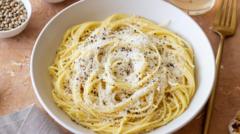A recipe for Cacio e Pepe published by Good Food has sparked widespread outrage in Italy, prompting backlash from chefs and food enthusiasts alike due to its inaccurate ingredient list and perceived disrespect toward a beloved dish.
Outrage Erupts in Italy Over Good Food's Cacio e Pepe Recipe Faux Pas

Outrage Erupts in Italy Over Good Food's Cacio e Pepe Recipe Faux Pas
Italians express dismay at inaccurate recipe and misrepresentation of a cherished culinary tradition.
In a recent uproar, the UK Good Food website has come under fire after it published a recipe for the traditional Roman pasta dish, Cacio e Pepe, that strayed significantly from its authentic roots. The dish, revered for its simplicity yet complexity in preparation, was described as a quick lunch option, causing many Italians to bristle at the perceived belittlement of this culinary classic.
The controversial recipe provided by Good Food listed spaghetti, black pepper, Parmesan cheese, and butter, plus an optional double cream addition. Authentic Cacio e Pepe, however, consists solely of three ingredients: spaghetti, black pepper, and Pecorino Romano cheese. The inclusion of butter and cream was particularly incendiary, leading the president of Italy's food association, Claudio Pica, to reach out to the British Embassy in Rome to express concern.
"It's astonishing to see such a misrepresentation on a well-known British food platform," Pica stated. He emphasized that the dish is a staple of Roman cuisine and has been cherished not just in Italy but globally. The reaction resonated throughout Italian media, with some journalists condemning the recipe as an egregious oversight.
Restaurant owners are equally dismayed. Giorgio Erami, who operates a pasta restaurant near St. Peter's Square, noted, "What Good Food published is not Cacio e Pepe; it’s a variation referred to as 'pasta Alfredo.'” He argued that using the traditional name for an altered dish is misleading and discredits the original recipe.
The culinary tension this incident has sparked reflects broader themes of national pride and the importance of culinary traditions in Italy. Maurizio, who runs a family hotel in Rome, remarked, “You cannot call it Cacio e Pepe if you add cream or butter—it transforms it completely.” The sentiment echoes across the nation; many Italians fear that altering recipes undermines their cultural identity.
While some chefs embrace creative interpretations of traditional dishes, many Italians believe that maintaining the integrity of their cuisine is paramount. Nicola, a sandwich shop owner near the Vatican, lamented, “Cacio e Pepe should never have cream. That’s for desserts!” In a country where food is a cornerstone of national heritage, the controversy serves as a reminder of the pride Italians take in their culinary traditions.
Good Food's parent company, Immediate Media, has yet to respond to commentary requests regarding the issue. The fallout over this culinary blunder illustrates the passionate connection Italians hold with their food—a connection that transcends mere ingredients to encompass culture and identity itself.




















